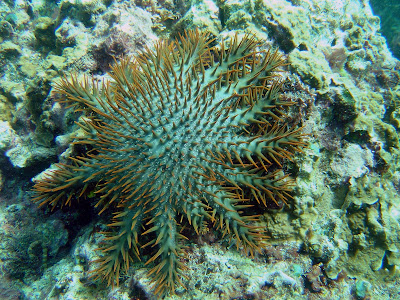Strange Sea creatures
Adaptations of creatures into monsters of dreams and mythology (and inspiration for films) can teach us lessons, and provide new gifts or treasures. Dr Anjani Ganase asks
us to look at some strange ocean creatures.
Living in the ocean requires a different set of skills
from living on the land. On land most of us, with the exception of those with
wings, are limited to moving around the earth’s surface. Most terrestrial animals
spend their lifetimes crossing the terrain for food, water, shelter and mates. The
ocean, however, has other properties: water allows organisms to move in all planes
and connects animal and plant life at much greater and more intimate scales where
water is also a medium of transport.
While the ocean is a 3D realm, it doesn’t make the
ocean homogenous as there are natural physical barriers that limit movement and
transport of marine life and material. For
example, the pressure exerted on our bodies increases with depth, owing to the
weight of water above, and light only shines through the first 100 m of the
water column, below which the rest of the ocean is a dark and mysterious abyss.
The adaptations of marine life in the oceans seem alien to us, and at the same
time fascinate us. We often refer to marine organisms, to draw ideas of what
aliens may look like and to inspire “monsters”, which are essentially any
creatures unknown to us. Yet, these strange and unusual traits are often simple
adaptations to survive in ocean environments, to help with their survival. Here
are a few “monstrous” traits that are used for survival.
 |
| Crown of Thorns Starfish in the Mariana Islands, Guam. Photo by David Burdick (NOAA photo library) |
What organism can split into two at will or regenerate
its limbs? Sea stars, similar to many other invertebrates, can split their body
as a form of asexual reproduction. They replicate themselves by growing and dividing.
This trait made the control of the Crown of Thorns starfish population on the Great
Barrier Reef difficult in the beginning. Crown of Thorns are voracious
predators to corals, and every so often, their populations reach outbreak
levels following years of heavy flooding or nutrient pollution. These outbreaks
would devastate reefs, as all of corals would be ravaged. Very quickly it was
realized that the attempt to control the population by cutting up the sea
stars, made the outbreak even worse as the populations were increasing instead
of declining. Today, the Crown of Thorns starfish are injected with saline
solution to kill them or the sea stars are simply removed from the coral reef,
and taken out of the water.
 |
| A hagfish protruding from a sponge. California, Channel
Islands, Santa Cruz
Photo courtesy NOAA Okeanos Explorer
Program
|
What creature can create up to 20 litres of slime while
knotting itself up for a slippery escape? The hagfish is an ancient jawless
fish that is closely related to lampreys and eels. They often scavenge the deep
ocean, feeding on dead organisms. This makes them important in cleaning up the
ocean of carrion and recycling nutrients. The slime of the hagfish is a keratin
compound that is excreted and binds with the water to produce slime. Up to 20
litres of this slime can be produced at a time, more than enough to slip out of
the jaws of a predator or clog their gills. Owing to the strength of the hagfish
slime, it is now being researched for use as a biodegradable raw material.
What buries itself in the sand and waits for
unsuspecting prey to swim by before reaching up to attack and pull the prey
below the sand for a meal? The bobbit worm can grow up to a metre in length. It
lunges at reef fish and crustaceans with its razor-sharp fangs. Their pharynx
can turn inside out and armed with finger-like projections, it can pull prey
into its mouth. The bobbit worm can also scavenge, moving along the reef at
night eating anything in its path. They’re found on most tropical reefs,
although its beautiful rainbow colours are rarely seen as they lie buried just
below the sand. Fish have some defensive mechanisms against the bobbit worm: schools
of fish can bombard it by squirting jets of water at it to reveal where it’s
hiding under the sand. While these worms inspire scenes from the movie Dune,
they are really no threat to humans.
 |
|
Spawning aggregation of horseshoe crab. Photo courtesy
Delaware National Estuarine Research Reserve
|
What has a large armoured plate, seven eyes, blue
blood and breathes from its legs? The horseshoe crab is a living ancient that
has been around for the last 450 million years (humans have only been around
for 5 million years). The horseshoe crab resides in the shallow waters of the
American and Asian coastlines. While they may look like relatives of crabs,
they are more closely related to scorpions and spiders. Their closest relative
– the sea scorpion - is now extinct. The blue blood of the horseshoe crab is
incredibly important in the medical industry. The blood of horseshoe crabs is
blue because of the presence of copper in the blood, which is used to form a
compound called limulus
amebocyte lysate (LAL) that is linked to the horseshoe’s adaptive immune response
and survival. When there is an infection the compound surrounds the bacteria
and coagulates as a defense response to remove the bacteria. Today, the blood
of horseshoe crabs is used to detect bacterial contamination in vaccines and
drugs and is therefore used by the pharmaceutical industry in quality control
of medicines.
The more we discover about the ocean and the organisms
that live there, the more we can learn how their traits can advance our society
in technology and science. Let us view them as unknown resources with magical
and mysterious, rather than monstrous, qualities.


